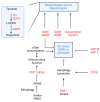Gene Therapy for Parkinson's Disease Using Midbrain Developmental Genes to Regulate Dopaminergic Neuronal Maintenance
- PMID: 39596436
- PMCID: PMC11594980
- DOI: 10.3390/ijms252212369
Gene Therapy for Parkinson's Disease Using Midbrain Developmental Genes to Regulate Dopaminergic Neuronal Maintenance
Abstract
Parkinson's disease (PD) is the second most prevalent neurodegenerative disorder. It is characterized by the progressive loss of dopaminergic (DAnergic) neurons in the substantia nigra and decreased dopamine (DA) levels, which lead to both motor and non-motor symptoms. Conventional PD treatments aim to alleviate symptoms, but do not delay disease progression. PD gene therapy offers a promising approach to improving current treatments, with the potential to alleviate significant PD symptoms and cause fewer adverse effects than conventional therapies. DA replacement approaches and DA enzyme expression do not slow disease progression. However, DA replacement gene therapies, such as adeno-associated virus (AAV)-glutamic acid decarboxylase (GAD) and L-amino acid decarboxylase (AADC) gene therapies, which increase DA transmitter levels, have been demonstrated to be safe and efficient in early-phase clinical trials. Disease-modifying strategies, which aim to slow disease progression, appear to be potent. These include therapies targeting downstream pathways, neurotrophic factors, and midbrain DAnergic neuronal factors, all of which have shown potential in preclinical and clinical trials. These approaches focus on maintaining the integrity of DAnergic neurons, not just targeting the DA transmitter level itself. In particular, critical midbrain developmental and maintenance factors, such as Nurr1 and Foxa2, can interact synergistically with neighboring glia, in a paracrine mode of action, to protect DAnergic neurons against various toxic factors. Similar outcomes could be achieved by targeting both DAnergic neurons and glial cells with other candidate gene therapies, but in-depth research is needed. Neurotrophic factors, such as neurturin, the glial-cell-line-derived neurotrophic factor (GDNF), the brain-derived neurotrophic factor (BDNF), and the vascular endothelial growth factor (VEGF), are also being investigated for their potential to support DAnergic neuron survival. Additionally, gene therapies targeting key downstream pathways, such as the autophagy-lysosome pathway, mitochondrial function, and endoplasmic reticulum (ER) stress, offer promising avenues. Gene editing and delivery techniques continue to evolve, presenting new opportunities to develop effective gene therapies for PD.
Keywords: Nurr1; Parkinson’s disease; adeno-associated virus; clinical trial; dopaminergic neuron; gene therapy; midbrain developmental genes; preclinical study.
Conflict of interest statement
The authors have no potential conflicts of interest to declare.
Figures



References
-
- Pringsheim T., Day G.S., Smith D.B., Rae-Grant A., Licking N., Armstrong M.J., de Bie R.M.A., Roze E., Miyasaki J.M., Hauser R.A., et al. Dopaminergic Therapy for Motor Symptoms in Early Parkinson Disease Practice Guideline Summary: A Report of the AAN Guideline Subcommittee. Neurology. 2021;97:942–957. doi: 10.1212/WNL.0000000000012868. - DOI - PMC - PubMed
Publication types
MeSH terms
Substances
Grants and funding
LinkOut - more resources
Full Text Sources
Medical

